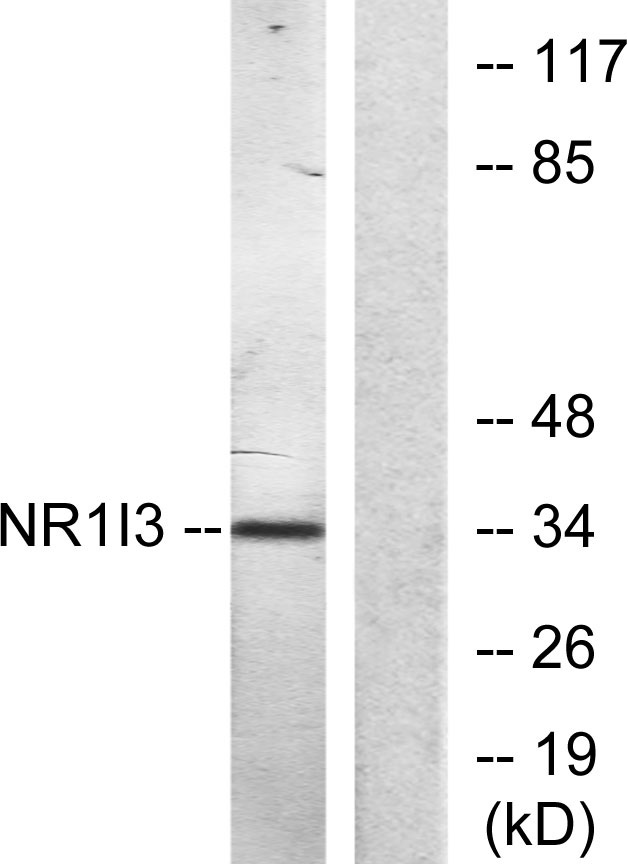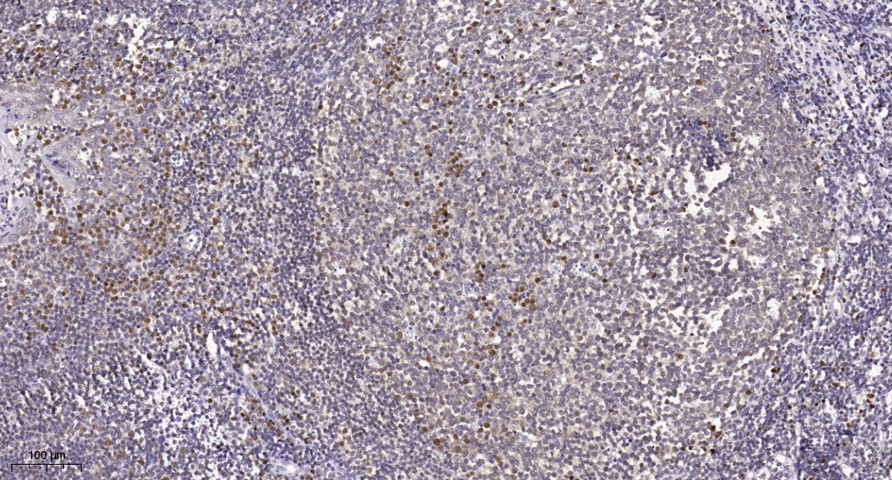MB67 Polyclonal Antibody
- Catalog No.:YT2670
- Applications:WB;IHC;IF;ELISA
- Reactivity:Human;Rat;Mouse;
- Target:
- MB67
- Fields:
- >>Chemical carcinogenesis - receptor activation
- Gene Name:
- NR1I3
- Protein Name:
- Nuclear receptor subfamily 1 group I member 3
- Human Gene Id:
- 9970
- Human Swiss Prot No:
- Q14994
- Mouse Swiss Prot No:
- O35627
- Immunogen:
- The antiserum was produced against synthesized peptide derived from human NR1I3. AA range:71-120
- Specificity:
- MB67 Polyclonal Antibody detects endogenous levels of MB67 protein.
- Formulation:
- Liquid in PBS containing 50% glycerol, 0.5% BSA and 0.02% sodium azide.
- Source:
- Polyclonal, Rabbit,IgG
- Dilution:
- WB 1:500 - 1:2000. IHC 1:100 - 1:300. ELISA: 1:20000.. IF 1:50-200
- Purification:
- The antibody was affinity-purified from rabbit antiserum by affinity-chromatography using epitope-specific immunogen.
- Concentration:
- 1 mg/ml
- Storage Stability:
- -15°C to -25°C/1 year(Do not lower than -25°C)
- Other Name:
- NR1I3;CAR;Nuclear receptor subfamily 1 group I member 3;Constitutive activator of retinoid response;Constitutive active response;Constitutive androstane receptor;CAR;Orphan nuclear receptor MB67
- Observed Band(KD):
- 35kD
- Background:
- This gene encodes a member of the nuclear receptor superfamily, and is a key regulator of xenobiotic and endobiotic metabolism. The protein binds to DNA as a monomer or a heterodimer with the retinoid X receptor and regulates the transcription of target genes involved in drug metabolism and bilirubin clearance, such as cytochrome P450 family members. Unlike most nuclear receptors, this transcriptional regulator is constitutively active in the absence of ligand but is regulated by both agonists and inverse agonists. Ligand binding results in translocation of this protein to the nucleus, where it activates or represses target gene transcription. These ligands include bilirubin, a variety of foreign compounds, steroid hormones, and prescription drugs. Multiple transcript variants encoding different isoforms have been found for this gene. [provided by RefSeq, Jul 2008],
- Function:
- domain:Composed by a short N-terminal domain followed by the DNA binding, hinge, and ligand binding/dimerization domains.,function:Binds and transactivates the retinoic acid response elements that control expression of the retinoic acid receptor beta 2 and alcohol dehydrogenase 3 genes. Transactivates both the phenobarbital responsive element module of the human CYP2B6 gene and the CYP3A4 xenobiotic response element.,induction:By dexamethasone.,similarity:Belongs to the nuclear hormone receptor family.,similarity:Belongs to the nuclear hormone receptor family. NR1 subfamily.,similarity:Contains 1 nuclear receptor DNA-binding domain.,subunit:Heterodimer of NR1I3 and RXR. Interacts with PSMC4.,tissue specificity:Predominantly expressed in liver.,
- Subcellular Location:
- Nucleus. Cytoplasm. Cytoplasm, cytoskeleton. Recruited to the cytoplasm by DNAJC7. .
- Expression:
- Predominantly expressed in liver.
- June 19-2018
- WESTERN IMMUNOBLOTTING PROTOCOL
- June 19-2018
- IMMUNOHISTOCHEMISTRY-PARAFFIN PROTOCOL
- June 19-2018
- IMMUNOFLUORESCENCE PROTOCOL
- September 08-2020
- FLOW-CYTOMEYRT-PROTOCOL
- May 20-2022
- Cell-Based ELISA│解您多样本WB检测之困扰
- July 13-2018
- CELL-BASED-ELISA-PROTOCOL-FOR-ACETYL-PROTEIN
- July 13-2018
- CELL-BASED-ELISA-PROTOCOL-FOR-PHOSPHO-PROTEIN
- July 13-2018
- Antibody-FAQs
- Products Images

- Western blot analysis of lysates from Jurkat cells, treated with serum 20% 15', using NR1I3 Antibody. The lane on the right is blocked with the synthesized peptide.

- Immunohistochemical analysis of paraffin-embedded human tonsil. 1, Tris-EDTA,pH9.0 was used for antigen retrieval. 2 Antibody was diluted at 1:200(4° overnight.3,Secondary antibody was diluted at 1:200(room temperature, 45min).



